Hantao Yao
Locality Preserving Markovian Transition for Instance Retrieval
Jun 05, 2025Abstract:Diffusion-based re-ranking methods are effective in modeling the data manifolds through similarity propagation in affinity graphs. However, positive signals tend to diminish over several steps away from the source, reducing discriminative power beyond local regions. To address this issue, we introduce the Locality Preserving Markovian Transition (LPMT) framework, which employs a long-term thermodynamic transition process with multiple states for accurate manifold distance measurement. The proposed LPMT first integrates diffusion processes across separate graphs using Bidirectional Collaborative Diffusion (BCD) to establish strong similarity relationships. Afterwards, Locality State Embedding (LSE) encodes each instance into a distribution for enhanced local consistency. These distributions are interconnected via the Thermodynamic Markovian Transition (TMT) process, enabling efficient global retrieval while maintaining local effectiveness. Experimental results across diverse tasks confirm the effectiveness of LPMT for instance retrieval.
Language Guided Concept Bottleneck Models for Interpretable Continual Learning
Mar 30, 2025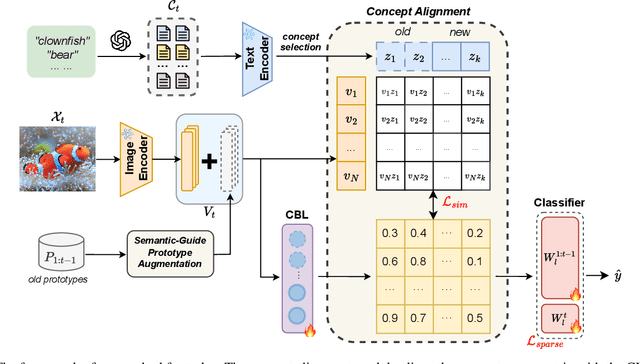


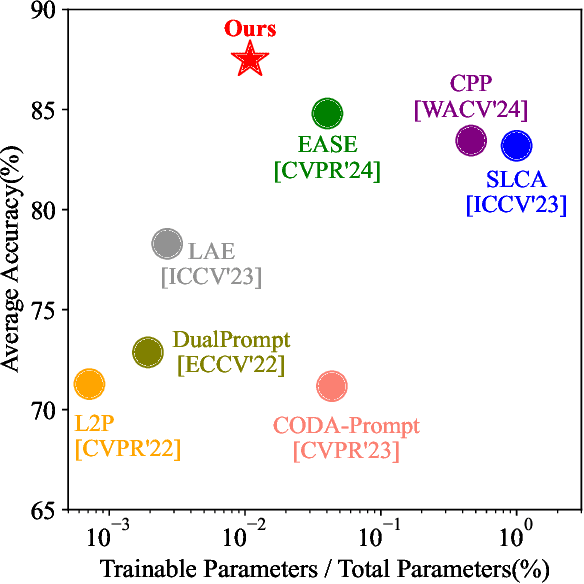
Abstract:Continual learning (CL) aims to enable learning systems to acquire new knowledge constantly without forgetting previously learned information. CL faces the challenge of mitigating catastrophic forgetting while maintaining interpretability across tasks. Most existing CL methods focus primarily on preserving learned knowledge to improve model performance. However, as new information is introduced, the interpretability of the learning process becomes crucial for understanding the evolving decision-making process, yet it is rarely explored. In this paper, we introduce a novel framework that integrates language-guided Concept Bottleneck Models (CBMs) to address both challenges. Our approach leverages the Concept Bottleneck Layer, aligning semantic consistency with CLIP models to learn human-understandable concepts that can generalize across tasks. By focusing on interpretable concepts, our method not only enhances the models ability to retain knowledge over time but also provides transparent decision-making insights. We demonstrate the effectiveness of our approach by achieving superior performance on several datasets, outperforming state-of-the-art methods with an improvement of up to 3.06% in final average accuracy on ImageNet-subset. Additionally, we offer concept visualizations for model predictions, further advancing the understanding of interpretable continual learning.
DA-Ada: Learning Domain-Aware Adapter for Domain Adaptive Object Detection
Oct 11, 2024
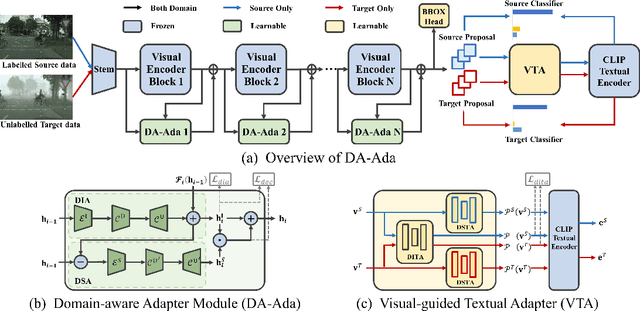
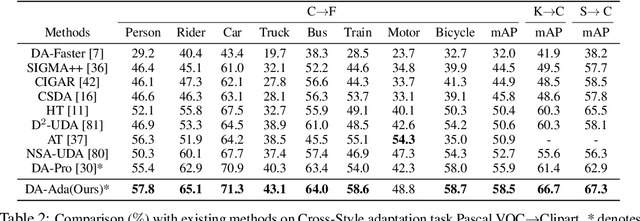

Abstract:Domain adaptive object detection (DAOD) aims to generalize detectors trained on an annotated source domain to an unlabelled target domain. As the visual-language models (VLMs) can provide essential general knowledge on unseen images, freezing the visual encoder and inserting a domain-agnostic adapter can learn domain-invariant knowledge for DAOD. However, the domain-agnostic adapter is inevitably biased to the source domain. It discards some beneficial knowledge discriminative on the unlabelled domain, i.e., domain-specific knowledge of the target domain. To solve the issue, we propose a novel Domain-Aware Adapter (DA-Ada) tailored for the DAOD task. The key point is exploiting domain-specific knowledge between the essential general knowledge and domain-invariant knowledge. DA-Ada consists of the Domain-Invariant Adapter (DIA) for learning domain-invariant knowledge and the Domain-Specific Adapter (DSA) for injecting the domain-specific knowledge from the information discarded by the visual encoder. Comprehensive experiments over multiple DAOD tasks show that DA-Ada can efficiently infer a domain-aware visual encoder for boosting domain adaptive object detection. Our code is available at https://github.com/Therock90421/DA-Ada.
Exploiting the Semantic Knowledge of Pre-trained Text-Encoders for Continual Learning
Aug 02, 2024


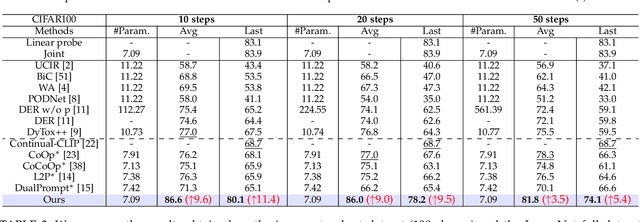
Abstract:Deep neural networks (DNNs) excel on fixed datasets but struggle with incremental and shifting data in real-world scenarios. Continual learning addresses this challenge by allowing models to learn from new data while retaining previously learned knowledge. Existing methods mainly rely on visual features, often neglecting the rich semantic information encoded in text. The semantic knowledge available in the label information of the images, offers important semantic information that can be related with previously acquired knowledge of semantic classes. Consequently, effectively leveraging this information throughout continual learning is expected to be beneficial. To address this, we propose integrating semantic guidance within and across tasks by capturing semantic similarity using text embeddings. We start from a pre-trained CLIP model, employ the \emph{Semantically-guided Representation Learning (SG-RL)} module for a soft-assignment towards all current task classes, and use the Semantically-guided Knowledge Distillation (SG-KD) module for enhanced knowledge transfer. Experimental results demonstrate the superiority of our method on general and fine-grained datasets. Our code can be found in https://github.com/aprilsveryown/semantically-guided-continual-learning.
Prompt-based Visual Alignment for Zero-shot Policy Transfer
Jun 05, 2024



Abstract:Overfitting in RL has become one of the main obstacles to applications in reinforcement learning(RL). Existing methods do not provide explicit semantic constrain for the feature extractor, hindering the agent from learning a unified cross-domain representation and resulting in performance degradation on unseen domains. Besides, abundant data from multiple domains are needed. To address these issues, in this work, we propose prompt-based visual alignment (PVA), a robust framework to mitigate the detrimental domain bias in the image for zero-shot policy transfer. Inspired that Visual-Language Model (VLM) can serve as a bridge to connect both text space and image space, we leverage the semantic information contained in a text sequence as an explicit constraint to train a visual aligner. Thus, the visual aligner can map images from multiple domains to a unified domain and achieve good generalization performance. To better depict semantic information, prompt tuning is applied to learn a sequence of learnable tokens. With explicit constraints of semantic information, PVA can learn unified cross-domain representation under limited access to cross-domain data and achieves great zero-shot generalization ability in unseen domains. We verify PVA on a vision-based autonomous driving task with CARLA simulator. Experiments show that the agent generalizes well on unseen domains under limited access to multi-domain data.
Cluster-Aware Similarity Diffusion for Instance Retrieval
Jun 04, 2024


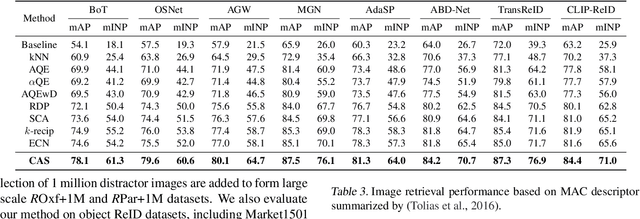
Abstract:Diffusion-based re-ranking is a common method used for retrieving instances by performing similarity propagation in a nearest neighbor graph. However, existing techniques that construct the affinity graph based on pairwise instances can lead to the propagation of misinformation from outliers and other manifolds, resulting in inaccurate results. To overcome this issue, we propose a novel Cluster-Aware Similarity (CAS) diffusion for instance retrieval. The primary concept of CAS is to conduct similarity diffusion within local clusters, which can reduce the influence from other manifolds explicitly. To obtain a symmetrical and smooth similarity matrix, our Bidirectional Similarity Diffusion strategy introduces an inverse constraint term to the optimization objective of local cluster diffusion. Additionally, we have optimized a Neighbor-guided Similarity Smoothing approach to ensure similarity consistency among the local neighbors of each instance. Evaluations in instance retrieval and object re-identification validate the effectiveness of the proposed CAS, our code is publicly available.
SEP: Self-Enhanced Prompt Tuning for Visual-Language Model
May 30, 2024Abstract:Prompt tuning based on Context Optimization (CoOp) effectively adapts visual-language models (VLMs) to downstream tasks by inferring additional learnable prompt tokens. However, these tokens are less discriminative as they are independent of the pre-trained tokens and fail to capture input-specific knowledge, such as class-aware textual or instance-aware visual knowledge. Leveraging the discriminative and generalization capabilities inherent in pre-trained tokens, we introduce a novel approach named Self-Enhanced Prompt Tuning (SEP). The core principle of SEP involves adapting the learnable prompt tokens at each encoder layer from the corresponding self-pretrained tokens, thereby explicitly incorporating discriminative prior knowledge to enhance both textual-level and visual-level embeddings. Furthermore, SEP's self-enhanced tokens not only boost discrimination but also mitigate domain shifts in unseen domains, enhancing generalization. In practice, SEP selects several representative tokens from all pre-trained tokens for each input data at every layer of the text/visual encoders. Subsequently, a Token Fusion Module (TFM) is introduced to generate a self-enhanced token by merging these representative tokens with the learnable tokens using a cross-attention mechanism. This self-enhanced token is then concatenated with all pre-trained tokens, serving as input for subsequent encoder layers to produce the relevant embeddings. Comprehensive evaluations across various benchmarks and tasks confirm SEP's efficacy in prompt tuning. Code: \href{Code}{https://github.com/htyao89/SEP}.
Hierarchical Prompts for Rehearsal-free Continual Learning
Jan 21, 2024Abstract:Continual learning endeavors to equip the model with the capability to integrate current task knowledge while mitigating the forgetting of past task knowledge. Inspired by prompt tuning, prompt-based methods maintain a frozen backbone and train with slight learnable prompts to minimize the catastrophic forgetting that arises due to updating a large number of backbone parameters. Nonetheless, these learnable prompts tend to concentrate on the discriminatory knowledge of the current task while ignoring past task knowledge, leading to that learnable prompts still suffering from catastrophic forgetting. This paper introduces a novel rehearsal-free paradigm for continual learning termed Hierarchical Prompts (H-Prompts), comprising three categories of prompts -- class prompt, task prompt, and general prompt. To effectively depict the knowledge of past classes, class prompt leverages Bayesian Distribution Alignment to model the distribution of classes in each task. To reduce the forgetting of past task knowledge, task prompt employs Cross-task Knowledge Excavation to amalgamate the knowledge encapsulated in the learned class prompts of past tasks and current task knowledge. Furthermore, general prompt utilizes Generalized Knowledge Exploration to deduce highly generalized knowledge in a self-supervised manner. Evaluations on two benchmarks substantiate the efficacy of the proposed H-Prompts, exemplified by an average accuracy of 87.8% in Split CIFAR-100 and 70.6% in Split ImageNet-R.
Hierarchical Augmentation and Distillation for Class Incremental Audio-Visual Video Recognition
Jan 11, 2024



Abstract:Audio-visual video recognition (AVVR) aims to integrate audio and visual clues to categorize videos accurately. While existing methods train AVVR models using provided datasets and achieve satisfactory results, they struggle to retain historical class knowledge when confronted with new classes in real-world situations. Currently, there are no dedicated methods for addressing this problem, so this paper concentrates on exploring Class Incremental Audio-Visual Video Recognition (CIAVVR). For CIAVVR, since both stored data and learned model of past classes contain historical knowledge, the core challenge is how to capture past data knowledge and past model knowledge to prevent catastrophic forgetting. We introduce Hierarchical Augmentation and Distillation (HAD), which comprises the Hierarchical Augmentation Module (HAM) and Hierarchical Distillation Module (HDM) to efficiently utilize the hierarchical structure of data and models, respectively. Specifically, HAM implements a novel augmentation strategy, segmental feature augmentation, to preserve hierarchical model knowledge. Meanwhile, HDM introduces newly designed hierarchical (video-distribution) logical distillation and hierarchical (snippet-video) correlative distillation to capture and maintain the hierarchical intra-sample knowledge of each data and the hierarchical inter-sample knowledge between data, respectively. Evaluations on four benchmarks (AVE, AVK-100, AVK-200, and AVK-400) demonstrate that the proposed HAD effectively captures hierarchical information in both data and models, resulting in better preservation of historical class knowledge and improved performance. Furthermore, we provide a theoretical analysis to support the necessity of the segmental feature augmentation strategy.
TCP:Textual-based Class-aware Prompt tuning for Visual-Language Model
Nov 30, 2023Abstract:Prompt tuning represents a valuable technique for adapting pre-trained visual-language models (VLM) to various downstream tasks. Recent advancements in CoOp-based methods propose a set of learnable domain-shared or image-conditional textual tokens to facilitate the generation of task-specific textual classifiers. However, those textual tokens have a limited generalization ability regarding unseen domains, as they cannot dynamically adjust to the distribution of testing classes. To tackle this issue, we present a novel Textual-based Class-aware Prompt tuning(TCP) that explicitly incorporates prior knowledge about classes to enhance their discriminability. The critical concept of TCP involves leveraging Textual Knowledge Embedding (TKE) to map the high generalizability of class-level textual knowledge into class-aware textual tokens. By seamlessly integrating these class-aware prompts into the Text Encoder, a dynamic class-aware classifier is generated to enhance discriminability for unseen domains. During inference, TKE dynamically generates class-aware prompts related to the unseen classes. Comprehensive evaluations demonstrate that TKE serves as a plug-and-play module effortlessly combinable with existing methods. Furthermore, TCP consistently achieves superior performance while demanding less training time.
 Add to Chrome
Add to Chrome Add to Firefox
Add to Firefox Add to Edge
Add to Edge